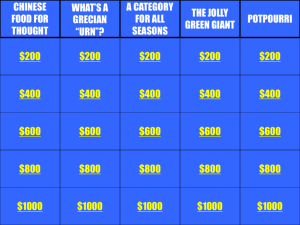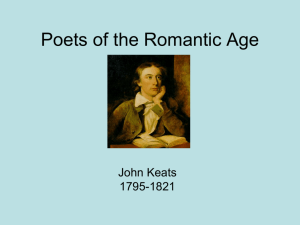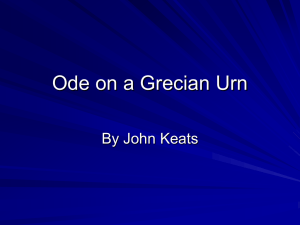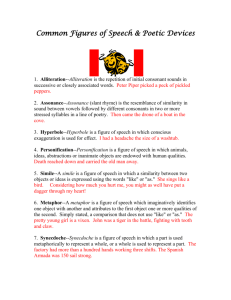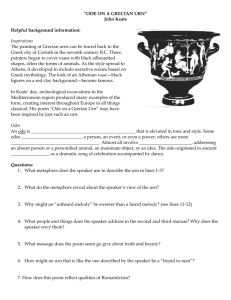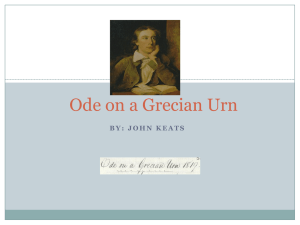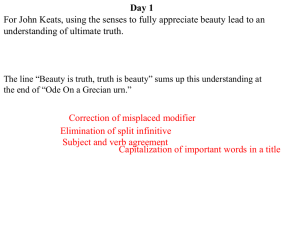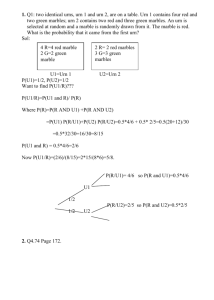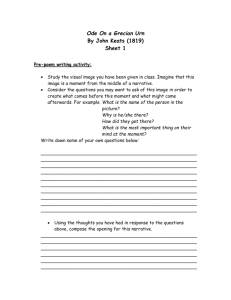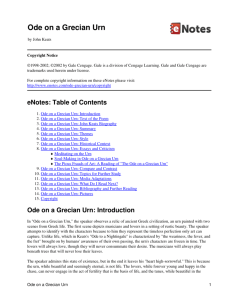Ode on a Grecian Urn--Critical Views.doc
advertisement
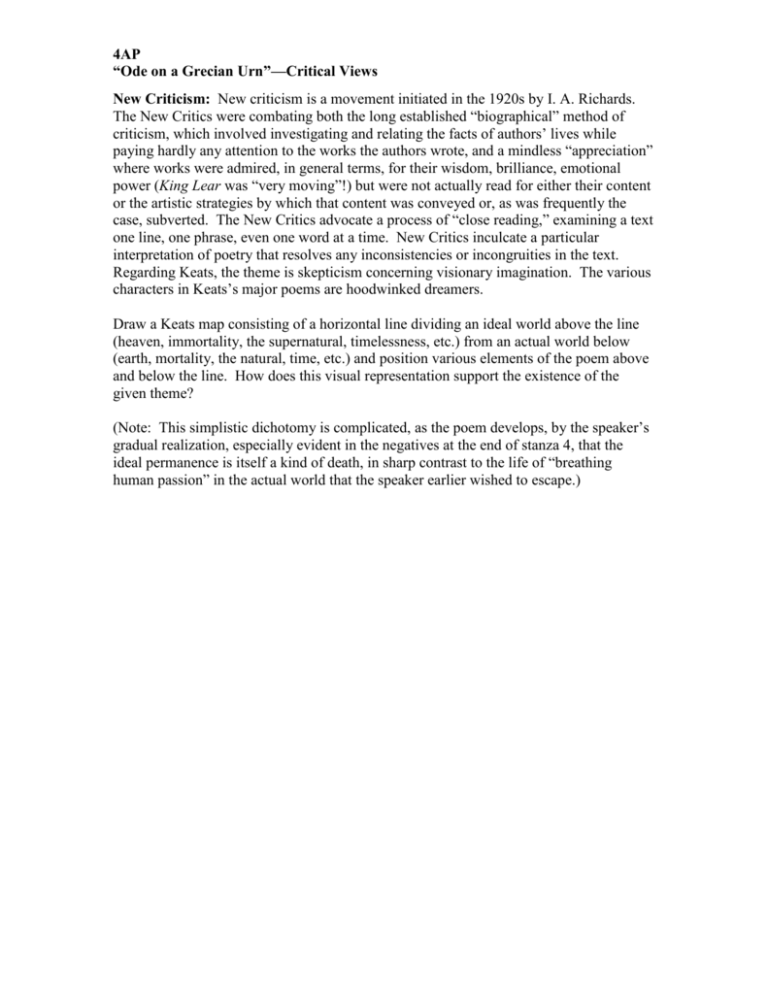
4AP “Ode on a Grecian Urn”—Critical Views New Criticism: New criticism is a movement initiated in the 1920s by I. A. Richards. The New Critics were combating both the long established “biographical” method of criticism, which involved investigating and relating the facts of authors’ lives while paying hardly any attention to the works the authors wrote, and a mindless “appreciation” where works were admired, in general terms, for their wisdom, brilliance, emotional power (King Lear was “very moving”!) but were not actually read for either their content or the artistic strategies by which that content was conveyed or, as was frequently the case, subverted. The New Critics advocate a process of “close reading,” examining a text one line, one phrase, even one word at a time. New Critics inculcate a particular interpretation of poetry that resolves any inconsistencies or incongruities in the text. Regarding Keats, the theme is skepticism concerning visionary imagination. The various characters in Keats’s major poems are hoodwinked dreamers. Draw a Keats map consisting of a horizontal line dividing an ideal world above the line (heaven, immortality, the supernatural, timelessness, etc.) from an actual world below (earth, mortality, the natural, time, etc.) and position various elements of the poem above and below the line. How does this visual representation support the existence of the given theme? (Note: This simplistic dichotomy is complicated, as the poem develops, by the speaker’s gradual realization, especially evident in the negatives at the end of stanza 4, that the ideal permanence is itself a kind of death, in sharp contrast to the life of “breathing human passion” in the actual world that the speaker earlier wished to escape.) 4AP “Ode on a Grecian Urn”—Critical Views Deconstruction: Deconstruction takes a view that literary works are disorganized, illogical, incoherent, essentially indeterminate, and employs a methodology of analyzing works to find mistakes, inconsistencies, gaps and contradictions. This theory could have been based solely on “Ode on a Grecian Urn,” because Keats himself had already written into his text those very incongruities and discordances that Deconstruction was established to expose. The poem has been deconstructing itself for almost 200 years, but for many readers it took the 1970s theorizing to make it permissible to say so. Critics now understand, in even the most admired poems, that some conflicts are not resolved into agreement, that some closures are not really achieved, and that readers who demand agreement and closure must supply them interpretively, compensating for lacks in the actual texts themselves. What paradox, contradictions, or gaps do you perceive in “Ode on a Grecian Urn”? 4AP “Ode on a Grecian Urn”—Critical Views Feminism: Feminism has enabled readers to see many imbalances in literature that were formerly invisible. Feminist readers investigate the sexual politics at work in a given piece of literature. For instance, in “Passion and Permanence in Keats’s Ode on a Grecian Urn” Charles Patterson suggests that Keats chose to write about an urn because its curved shape resembled that of a woman. What sexual politics are at work in this ode, or at least on the urn itself? 4AP “Ode on a Grecian Urn”—Critical Views New Historicism: New Historicism is an approach based on the idea of literature as a social activity involving not only authors but publishers, editors, printers, booksellers, purchasers, readers, reviewers, critics, teachers, students, and a great deal of nonliterary historical context, including the political and social ideas of everyone involved, local and international, and so on. In its political emphasis, New Historicism began as a delicate outgrowth of Marxist criticism. Politics have always been central in the writings of Blake, Byron, and Percy Shelley among the Romantics. But what, critics used to ask, can there possibly be of political interest in “Ode on a Grecian Urn,” where a speaker is confronting an old Greek vase with pictures depicting lovers, pipers, trees, a sacrificial process, and musing on vague abstractions about Beauty and Truth? As it turns out, critics beginning in the 1980s have discovered plenty of political concerns in the poem. Keats’s centering the poem in Greek life and culture made a point about the ancient origins of the modern revolutionary spirit, for example, and publishing it in Annals of the Fine Arts constituted an attack on the art establishment of the time. What other political statements can you identify? 4AP “Ode on a Grecian Urn”—Critical Views Reader-Response: Reader-response criticism makes it increasingly reasonable to accept the diversity of individual responses to complex poetic texts. Some reader response critics advocate a practice of “no-fault reading” whereby responses cannot be right or wrong, merely more or less interesting. Readers combine their own personal experiences with the given text to arrive at meaning. Jack Stillinger, advocates a practice of “no-fault reading” whereby responses cannot be right or wrong, merely more or less interesting. What is your response to “Ode on a Grecian Urn”? Reader Meaning Text (you) (“Ode on a Grecian Urn”) What personal qualities, or events relevant to this particular book, might influence my response? What textual features might influence my response? 4AP “Ode on a Grecian Urn”—Critical Views Negative Capability: Keats’s ideal of poetic disinterestedness—“Negative Capability,” he called it, “when man is capable of being in uncertainties, Mysteries, doubts, without any irritable reaching after fact & reason” (Keats’s Letters 1:193)—can be usefully applied to “Ode on a Grecian Urn.” In the first place exists a negatively capable author/speaker who asks a great many questions about activities depicted on the urn, receives no answers to his questions (unless “Beauty is truth” is supposed to be one), but remains content in his situation of uncertainties, mysteries, doubts. He is content simply because the final lines, while lacking the logic that would enable clear paraphrase, have an unmistakable air of resolution about them—the message is from “a friend to man” and its wisdom is “all ye need to know.” And in the second place, with the help of readerresponse thinking the readers are negatively capable as well, who, like the author/speaker, similarly don’t know the answers to the questions but are satisfied without knowing, accepting at the end a kind of contented irresolution.
